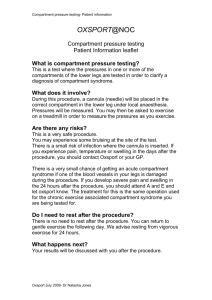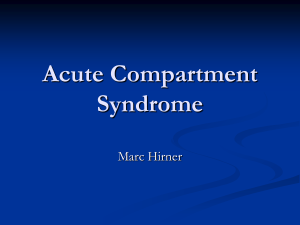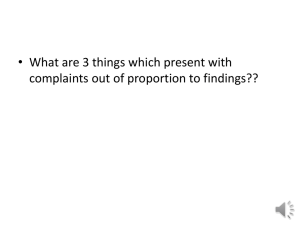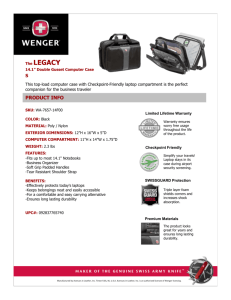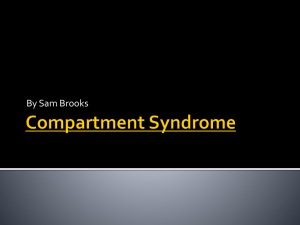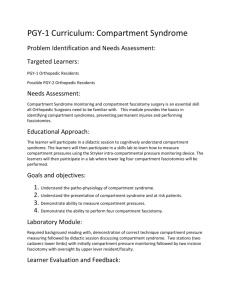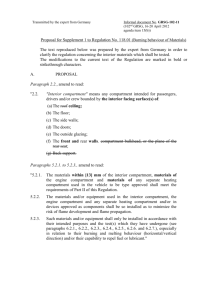ppt - Open.Michigan
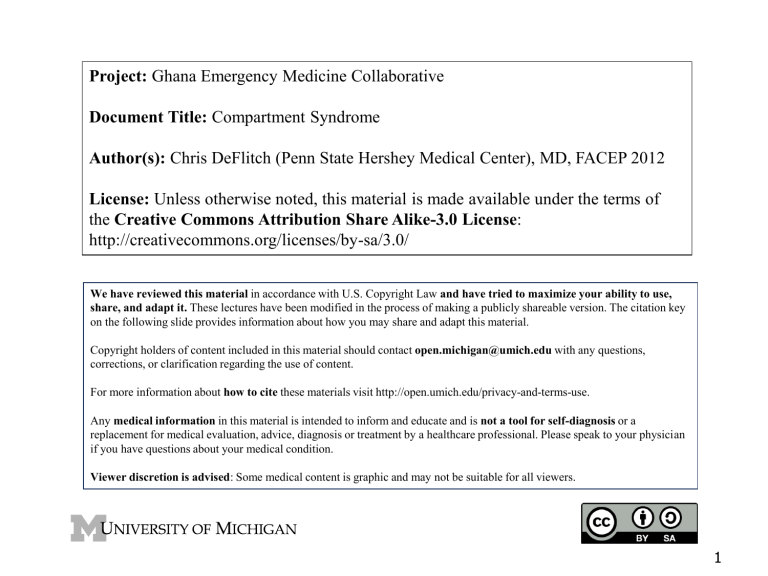
Project: Ghana Emergency Medicine Collaborative
Document Title: Compartment Syndrome
Author(s): Chris DeFlitch (Penn State Hershey Medical Center), MD, FACEP 2012
License: Unless otherwise noted, this material is made available under the terms of the Creative Commons Attribution Share Alike-3.0 License : http://creativecommons.org/licenses/by-sa/3.0/
We have reviewed this material in accordance with U.S. Copyright Law and have tried to maximize your ability to use, share, and adapt it.
These lectures have been modified in the process of making a publicly shareable version. The citation key on the following slide provides information about how you may share and adapt this material.
Copyright holders of content included in this material should contact open.michigan@umich.edu
with any questions, corrections, or clarification regarding the use of content.
For more information about how to cite these materials visit http://open.umich.edu/privacy-and-terms-use.
Any medical information in this material is intended to inform and educate and is not a tool for self-diagnosis or a replacement for medical evaluation, advice, diagnosis or treatment by a healthcare professional. Please speak to your physician if you have questions about your medical condition.
Viewer discretion is advised : Some medical content is graphic and may not be suitable for all viewers.
1
Attribution Key for more information see: http://open.umich.edu/wiki/AttributionPolicy
Use + Share + Adapt
{ Content the copyright holder, author, or law permits you to use, share and adapt. }
Public Domain – Government : Works that are produced by the U.S. Government. (17 USC § 105)
Public Domain – Expired : Works that are no longer protected due to an expired copyright term.
Public Domain – Self Dedicated : Works that a copyright holder has dedicated to the public domain.
Creative Commons – Zero Waiver
Creative Commons – Attribution License
Creative Commons – Attribution Share Alike License
Creative Commons – Attribution Noncommercial License
Creative Commons – Attribution Noncommercial Share Alike License
GNU – Free Documentation License
Make Your Own Assessment
{ Content Open.Michigan believes can be used, shared, and adapted because it is ineligible for copyright. }
Public Domain – Ineligible : Works that are ineligible for copyright protection in the U.S. (17 USC § 102(b)) *laws in your jurisdiction may differ
{ Content Open.Michigan has used under a Fair Use determination. }
Fair Use : Use of works that is determined to be Fair consistent with the U.S. Copyright Act. (17 USC § 107) *laws in your jurisdiction may differ
Our determination DOES NOT mean that all uses of this 3rd-party content are Fair Uses and we DO NOT guarantee that your use of the content is Fair.
To use this content you should do your own independent analysis to determine whether or not your use will be Fair. 2
Compartment Syndrome
Chris DeFlitch, MD, FACEP
Director & Vice-Chair
Department of Emergency Medicine
Penn State Hershey Medical Center
3
Case Presentation
23yo deaf male with Left lower extremity injury after motocross event
Questions?
4
History that’s Important
Mechanism of Injury
Associated Complaints
Associated Injury
P Q R S T
5
Physical Findings ?
ABC’s
Vital Signs
Associated Injury
Local Examination
Joint Above & Below
Neurovascular Status
6
What’s the Differential Dx?
Life threatening
Most Common
Bizzare Stuff
Things to Impress your Attending
7
3.
4.
1.
2.
5.
What YOUR Assessment & Plan ?
Anti-inflammatory medications ?
Narcotics ?
Imaging ?
Consultation ?
Ask the Attending ?
8
Your
Interpretation
Want another view ?
Source undetermined
9
Diagnosis ?
YEP…ITS NORMAL
Source undetermined
10
3.
4.
1.
2.
What’s the ED Disposition ?
Admission
Observation
Discharge
Consultation for Specific Procedure
3. DISCHARGE
11
Guess What…….
The patient came back with…..
Increasing PAIN, especially with Passive range of motion
Paresthesia
Pallor
Pulselessness
Paralysis
And had COMPARTMENT SYNDROME
12
Objectives
Define Compartment Syndrome
Understand the Pathophysiology
Consider Anatomic Factors
Identify Signs & Symptoms
Define Diagnostic & Treatment Options
13
Compartment Syndrome
TRUE EMERGENCY
Increase Pressure in Closed space
(compartments)
Most Common with Leg Injury/Fracture
Can occur with thigh, forearm, arm, hand, or foot injury
14
Mechanism Associated
Crush Injury
Fractures (closed)
Burns
Prolonged Procedures/Pressure
Spontaneous Hemorrhage
External Pressure (cast, MAST)
Overuse Syndromes
15
Pathophysiology
Increased Pressure in a CLOSED compartment
Increased Compartment Contents
Decreased Compartment Space/volume
Increased External Pressure
16
Cellular Physiology
Compartment Pressure > Diastolic
Venous vascular congestion
Tissue Ischemia
Release of Histamine increasing membrane permeability
Increasing Compartment Pressure
Arterial Vasospasm plays a minimal Role
17
Anatomic Considerations
CAN affect ANY
CLOSED COMPARTMENT
Leg
Anterior – MOST FREQUENT
Lateral
Deep Posterior
Superficial Posterior
18
Other Extremities
Thigh
Quadriceps
Forearm
Dorsal
Volar
Hand & Foot
Interosseous
Arm
Biceps
Deltoid
19
CLASSIC “5 P’s”
Pain
Paralysis
Paresthesia
Pallor
Pulselessness
Said together, but if they’re all there
…the 6 th P…….PATIENT is in trouble
20
Clinical Presentation
Pain
Out of Proportion to exam
Deep, burning,
Unrelenting
Frequent Revisit for MORE PAIN MEDS
THEY AIN’T DRUG SEEKERS !!!!
21
Physical Exam
Pain with PASSIVE stretching
Pain with Active Flexing
Paralysis (secondary to pain)
Tense or “full” compartment
Be Careful….some you can’t palpate
22
The other 3 P’s
Paresthesia – earlier sign
PALLOR
Pulselessness
LATE, OMINOUS SIGNS
23
Diagnosis
High Index of Suspicion
GOOD H&P
Insure neurovascularity Intact
Consider extremity XR
Early Orthopedic Consultation
Compartment Pressure Measurement
>30 mmHg
24
Pressure Measurement
Stryker Machine
(needle with transducer)
Baseline machine to atmosphere pressure
Should Read ZERO
Prep Area
18 G Needle into Compartment
Sometime hard with SMALL compartment
Inject small amount of Saline
Measure Plateau Pressure At Least 2 times
25
Tissue Pressure Gradient
0 mmHg NORMAL
10-30 mmHg Variable
30 mmHg Microcirculation Impaired
Within 30 mmHg of diastolic BP
Tissue Ischemia
26
Complications
Tissue Necrosis & Loss
Nerve damage
Contractures
Amputation
Cosmetic Deficit
Rhabdomyolysis---Renal Failure
Hyperkalemia
Myoglobinuria
27
Fasciotomy
Definitive Treatment
OPEN the Closed Compartment
Indication For Fasciotomy
Pressures >30
Pressures within 30mmHg of Mean Arterial
Pressure
28
Back to the Patient
Had Clinical findings of Compartment syndrome
LATE Findings
Flown to Tertiary Care Medical Center
Fasciotomy
Prolonged Course
29
The OUTCOME
He still has his Leg
BUT with a
Significant Cosmetic
& Functional Defect
30
QUESTIONS ?
THANK YOU !!!!!
31
